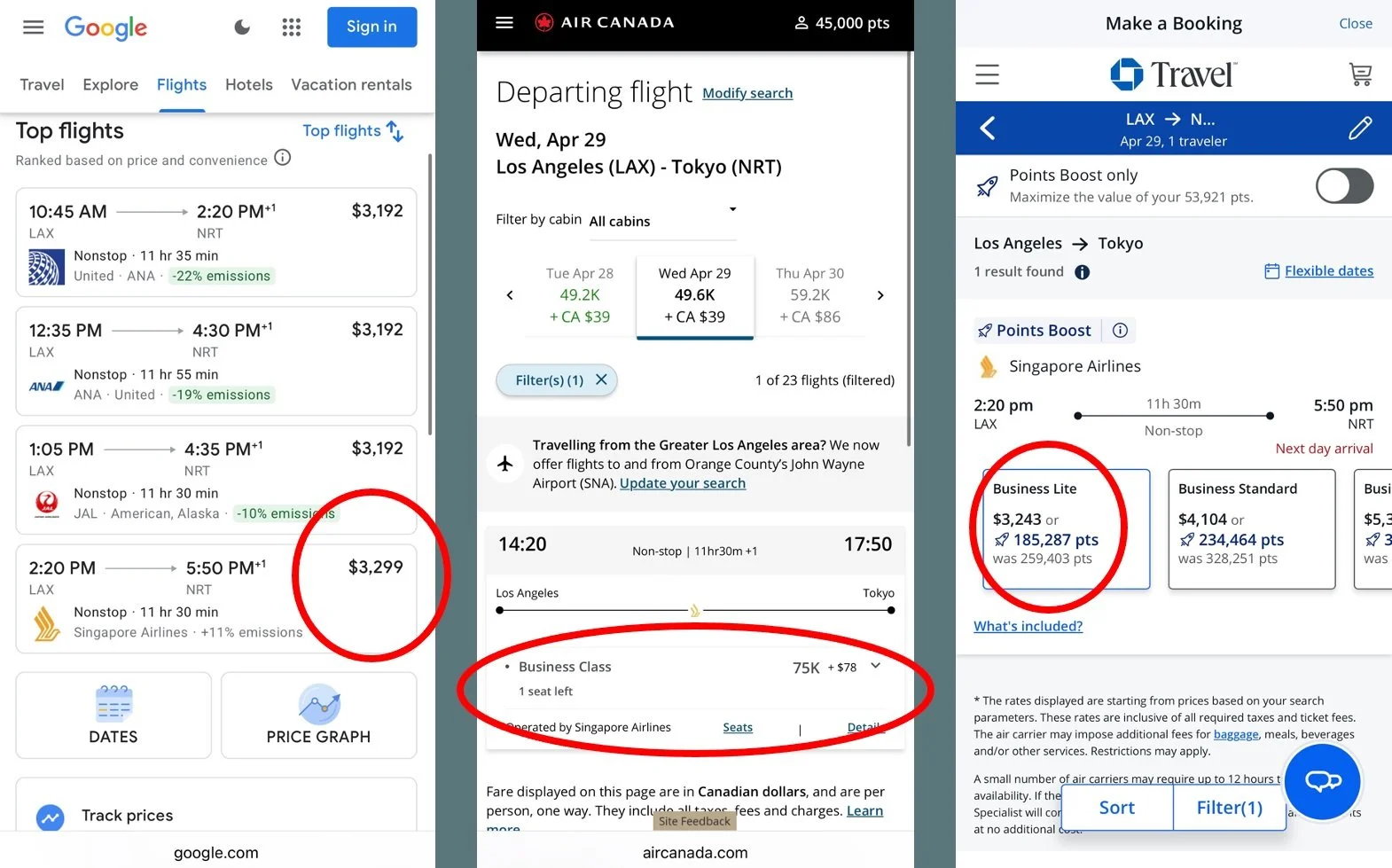Start Here: How to Use Chase and Amex Points for Flights Like a Pro
If you're just starting your journey into the world of points and miles, welcome. This post is your jumping-off point—the one to read before diving into advanced booking strategies, award charts, or sweet spot redemptions. Whether you’re trying to fly business class to Tokyo or score a free domestic flight home for the holidays, this guide will give you the essential framework for using Chase Ultimate Rewards (UR) or American Express Membership Rewards (MR) points for flights via transfer partners.
Why Transfer Partners Are the Key to Unlocking Maximum Value
Chase and Amex both offer flexible points that can be transferred to airline and hotel partners. These points are far more powerful than cash-back or shopping portal redemptions because they let you access airline award charts—where your points are worth exponentially more!
For example, instead of using 185,287 points to book a $3,299 business class flight to Tokyo through the Chase travel portal (1.8 cents per point, or 1.8 CPP), you could transfer just 75,000 points to an airline partner and book the exact same lie-flat seat—getting 4.4 CPP and the equivalent of $750 in value for an 11-hour flight.
Meet the Ecosystems: Chase vs. Amex
🟦 Chase Ultimate Rewards (UR)
The easiest way to earn Chase points is by putting your everyday spending on their cards — whether it’s dining, groceries, or travel. These categories earn solid rewards, so you can rack up points quickly without chasing complicated bonus categories.
Main cards that earn Chase Ultimate Rewards:
Chase Sapphire Preferred® (CSP):
2x on travel, 3x on dining, online grocery (excluding Target/Wholesale clubs), and select streaming,
5x on travel booked through Chase Travel℠,
1x on everything else
Chase Sapphire Reserve® (CSR):
3x on travel and dining,
10x on hotels and car rentals through Chase Travel,
5x on flights through Chase Travel,
1x on everything elseChase Freedom Unlimited® (CFU):
1.5x on all purchases,
3x on dining and drugstores,
5x on travel booked through Chase Travel
Note: You must hold a Sapphire Preferred, Sapphire Reserve, or Ink Business Preferred card to transfer points. Freedom Unlimited points become transferable when paired with one of these.
Chase airline transfer partners (1:1 ratio):
Aer Lingus AerClub, Air Canada Aeroplan, British Airways Executive Club, Emirates Skywards, Air France/KLM Flying Blue, Iberia Plus, JetBlue TrueBlue, Singapore Airlines KrisFlyer, Southwest Airlines Rapid Rewards, United MileagePlus, Virgin Atlantic Flying Club
Transfers are usually instant—especially to United, Aeroplan, British Airways, and Southwest.
🟨 Amex Membership Rewards (MR)
Maximize points by using your Amex cards on everyday spending like hotels, flights, and dining. These categories earn elevated rewards, helping you build points quickly for valuable transfer partners.
Main cards that earn Amex Membership Rewards:
The Platinum Card® from American Express:
5x on flights booked directly with airlines or through Amex Travel (on up to $500K/year),
5x on prepaid hotels booked through Amex Travel,
1x on everything elseAmerican Express® Gold Card:
4x at restaurants worldwide,
4x at U.S. supermarkets (on up to $25K/year),
3x on flights booked directly with airlines or through Amex Travel,
1x on everything else
Amex airline transfer partners:
Aer Lingus AerClub, Aeromexico Club Premier (1:1.6 ratio), Air Canada Aeroplan, Air France/KLM Flying Blue, ANA Mileage Club, Avianca LifeMiles, British Airways Executive Club, Cathay Pacific Asia Miles, Delta SkyMiles, Emirates Skywards, Etihad Guest, Hawaiian Airlines HawaiianMiles, Iberia Plus, JetBlue TrueBlue, Qantas Frequent Flyer, Qatar Airways Privilege Club, Singapore Airlines KrisFlyer, Virgin Atlantic Flying Club
Most Amex transfers are 1:1, though a few (like Aeromexico) differ. Some partners transfer instantly; others (like ANA or Iberia) can take a couple of days.
When (and Why) You Should Transfer Points
Only transfer when you're ready to book.
Transfers are one-way and irreversible. Points lose flexibility once moved to an airline program, so don’t transfer “just in case.” Always confirm award space first.
Use transfer partners when:
• You want to fly in business or first class
• You’re booking with airline miles that offer lower redemption rates (sweet spots)
• You're open to flying international carriers (which often offer better availability and pricing)
Real World Examples
Fly to Japan in ANA business class using 60,000 Amex points roundtrip by transferring them to Air Canada Aeroplan (vs. paying $4,000+ cash on ANA)
Book a domestic United flight using 6,000 Chase points transferred to United MileagePlus instead of 15,000 points through the Chase portal
Experience Qatar Airways Qsuites for just 70,000 Amex points via British Airways Avios
These are the types of redemptions I’ve covered in other posts—but understanding the transfer ecosystem is where it all begins.
Pro Tips Before You Dive Deeper
Know your goals. Want to fly lie-flat? Stay flexible? Book last-minute? Your redemption strategy should align with how you travel.
Use point transfer calculators and award search engines. I’ll break these down in future guides. Check out my cents per points (CPP) calculator to see how much you have saved here.
Keep your accounts open and active. Make sure you have frequent flyer accounts set up with major partners before transferring.
What’s Next?
Now that you understand the value of transferring Chase or Amex points to airline partners, you're ready to explore the specifics—like how to actually book that Emirates first class flight, or how to search United award space like a pro. I’ll be covering all that and more in upcoming posts.
But it all starts here—with flexible points, a bit of strategy, and a willingness to learn the game. The upside? Once you get it, you’ll never look at airfare the same way again.




